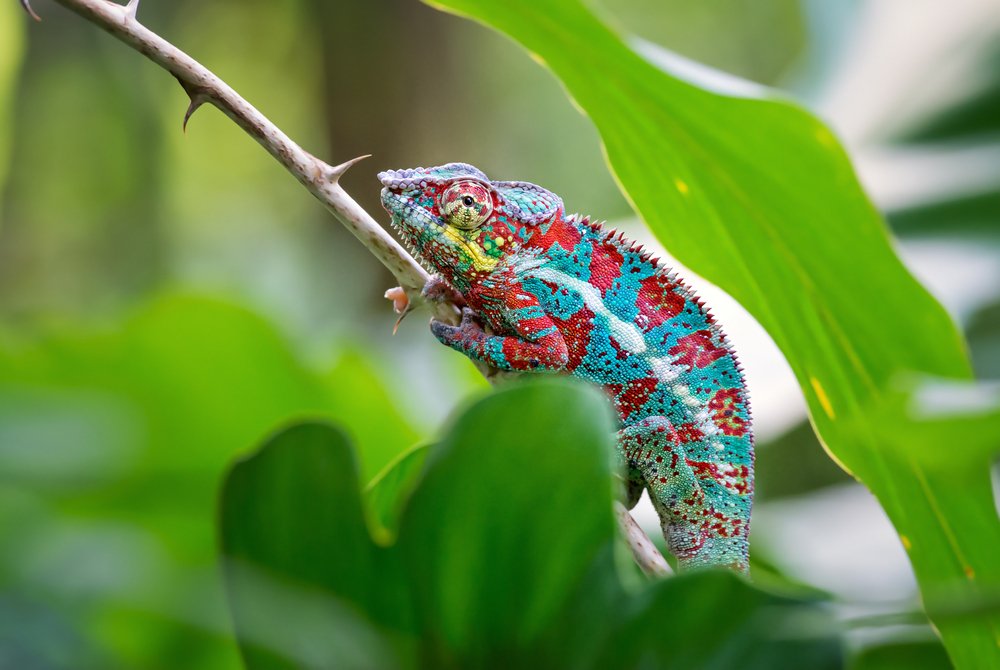

When the cells move closer together, they can express darker colors that have shorter wavelengths, such as blue or purple. But when a chameleon responds to an external stimulus, the iridophores move either closer together or farther apart, giving them the ability to reflect different colors of light. Pigments are held in tiny sacs inside the chameleon’s body. With chameleons, their pigment cells, called iridophores, essentially act like mirrors and are capable of reflecting a much wider range of colors. But the difference between chameleons and other reptiles is that their reptile friends have cells that are only capable of absorbing and reflecting certain colors. Most animals have pigmented cells that reflect light in order to express a certain coloring.

Let’s get you those answers in this article. So, why do they carry out this entertaining act? And how do their specialized cells actually work? These are things that have always puzzled us and now we want answers. But, a lot of your preconceived notions about why chameleons change colors might actually be somewhat wrong.Īs it turns out, not every color a chameleon changes to is a form of camouflage. But did you know that they do this as a result of specialized cells in their body and have a range of colors greater than most ?Īs you likely know already, the reason your chameleon changes color is to blend into his surroundings-at least that’s what we always assumed. If you own a pet chameleon, one of your reasons for doing so is probably because of their awesome color-changing abilities. You should increase it if it is too difficult to obtain blue notes and decrease it if it is too easy.The information is current and up-to-date in accordance with the latest veterinarian research. MAX BADNESS: This correspond to the maximum weighted delay considered for the coloration (red note). For other instruments, "WEIGHT END (-)" should probably be equal to "WEIGHT END (+)". For wind instruments, the player sometimes needs to breath between two notes, so there should be more tolerance for a negative delay than a positive one. WEIGHT END (-): This corresponds to the weight attributed to the delay between the score and the instrument at the end of the note if the instrument ends in advance. WEIGHT END (+): This corresponds to the weight attributed to the delay between the score and the instrument at the end of the note if the instrument is late. WEIGHT START: This corresponds to the weight attributed to the delay between the score and the instrument at the beginning of the note in the computation of the color. Midi Instrument channel: It's probably always 0. If you change the name, you should click on "restart synth" to be able to ear the instrument. You can use "aconnect -i" (with and without connecting the instrument) to find its name. Midi Instrument name: The name of the midi instrument in order to be able to connect its output to the plugin and to qsynth.

Score channel : if the current score as multiple parts, you can select the one you want to play (0 is the first part, 1 is the second. Some settings can be changed in the plugin interface (you can also permanently change the default values in the MidiInstrumentTraining.qml file): You must edit the "MidiInstrumentTraining.qml" file to set the default settings, especially the folder in which the plugin is installed (pluginsPath) and the folder in which midi files are stored (midiPath). Then it colors the note depending on these delays. For each note, it computes the delay between the beginning of the note in the midi file and the beginning of the note you played, and the same for the end of the note. The plugin compares the output of aplaymidi (which reads the midi file) with the output of the instrument. The plugin needs aplaymidi and aconnect (alsa-utils package in ubuntu), as well as qsynth (fluid synth) in order to ear the instrument. The score must have been exported in MIDI format before. This (probably linux-only) plugin (for MuseScore 2.0) takes input from a MIDI instrument and colors notes while you play from blue (note and rhythm are perfect) to red (bad note or bad rhythm).


 0 kommentar(er)
0 kommentar(er)
